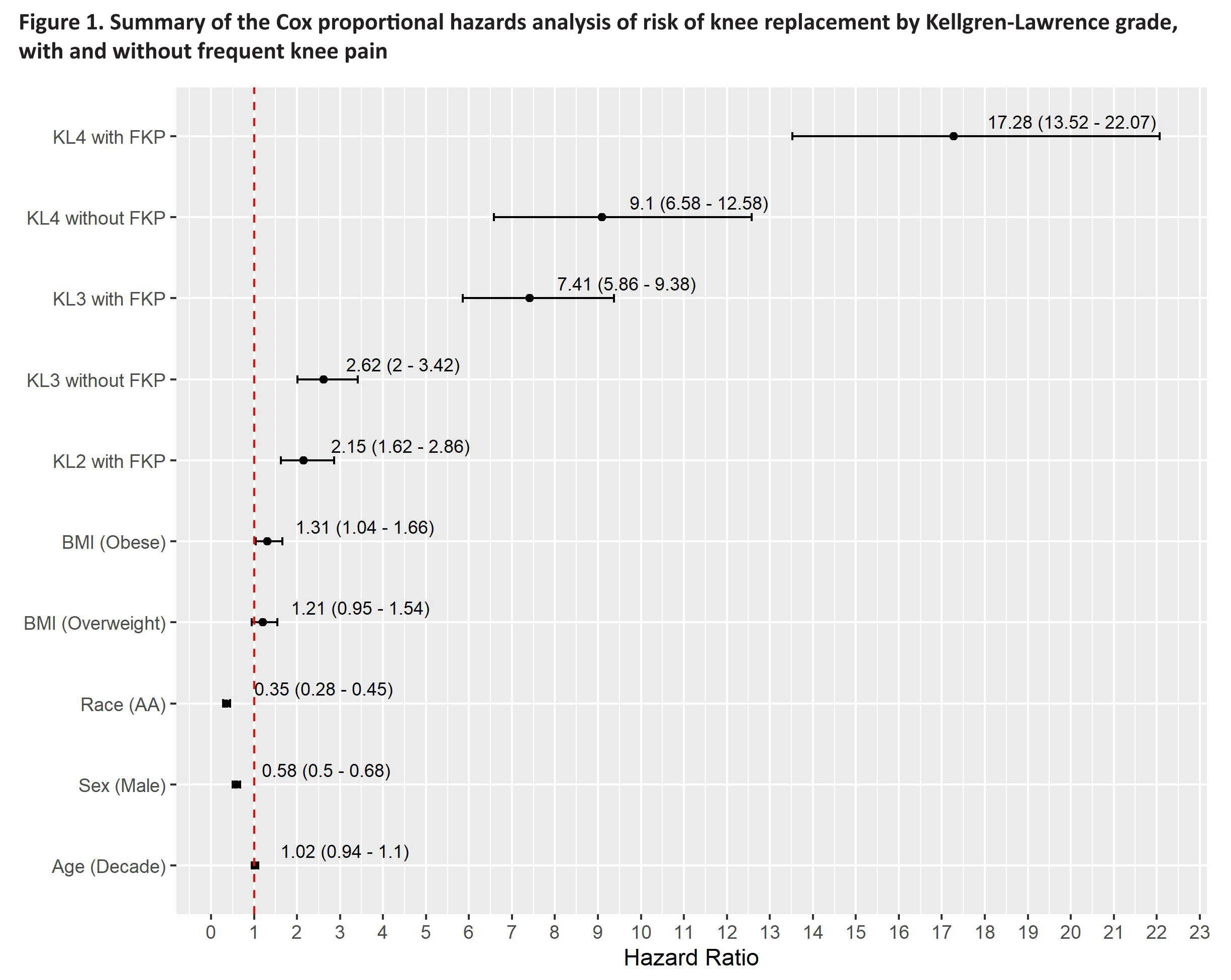Session Information
Session Type: Poster Session B
Session Time: 10:30AM-12:30PM
Background/Purpose: Receipt of knee replacement has been proposed by the FDA as a structural and symptom outcome for clinical trials of Disease Modifying Osteoarthritis Drugs (DMOADs). DMOAD trials have traditionally focused on enrolling knees that are Kellgren-Lawrence grade 2 and 3, but there has recently been consideration of enrolling Kellgren-Lawrence grade 4 knees with knee replacement as the outcome. Frequent knee pain (i.e., pain on more than half the days of the past 30 days) has often been an enrollment criterion in DMOAD trials, but patient report of frequent knee pain can be inconsistent and variable over time. Our objective was to compare time to knee replacement for knees with and without frequent knee pain by Kellgren-Lawrence grade.
Methods: We identified knees with and without frequent knee pain from the Multicenter Osteoarthritis Study (MOST) and the Osteoarthritis Initiative (OAI). Participants underwent fixed flexion posterior-anterior knee radiography at baseline and central reading of KLG by the same experienced readers. We evaluated time to knee replacement by categories defined by Kellgren-Lawrence grade and frequent knee pain presence with a Cox proportional hazards model, using Kellgren-Lawrence grade 2 without frequent knee pain as the reference group. All models were adjusted for age, sex, race and BMI. We tested an interaction between frequent knee pain and Kellgren-Lawrence grade.
Results: The sample consisted of 4,031 participants who contributed 6,148 knees (MOST: 1,550 participants, 2,355 knees; OAI: 2,481 participants, 3,793 knees). The demographic characteristics (i.e., age, sex, race, and BMI) are summarized in Table 1. Kellgren-Lawrence grade distribution of the two cohorts are summarized in Table 2. Figure 1 is a Forest plot that summarizes of the Hazard Ratios and 95% confidence intervals (CI) by Kellgren-Lawrence grade and frequent knee pain. There is a suggestion of a significant interaction between frequent knee pain and Kellgren-Lawrence grade (Wald Test, p=0.05).
Conclusion: The hazard ratios of knee replacement are higher for those with frequent knee pain at baseline compared to those without frequent knee pain at baseline, with increasing rates of knee replacement by Kellgren-Lawrence grade. Even without the presence of frequent knee pain at baseline, knees with Kellgren-Lawrence 3 or Kellgren-Lawrence 4 at baseline had clinically and statistically signficant Hazard Ratios for KR. These data may provide information for the planning of knee osteoarthritis intervention trials where knee replacement is an outcome of interest.
To cite this abstract in AMA style:
Kwoh K, Tang R, Bedrick E, Duryea J, Li Z, Liew J, Sun X, Neogi T. Time to Knee Replacement by Kellgren-Lawrence Grade and Presence of Frequent Knee Pain in Two Large and Diverse Longitudinal Cohorts: Data from MOST and OAI [abstract]. Arthritis Rheumatol. 2024; 76 (suppl 9). https://acrabstracts.org/abstract/time-to-knee-replacement-by-kellgren-lawrence-grade-and-presence-of-frequent-knee-pain-in-two-large-and-diverse-longitudinal-cohorts-data-from-most-and-oai/. Accessed .« Back to ACR Convergence 2024
ACR Meeting Abstracts - https://acrabstracts.org/abstract/time-to-knee-replacement-by-kellgren-lawrence-grade-and-presence-of-frequent-knee-pain-in-two-large-and-diverse-longitudinal-cohorts-data-from-most-and-oai/



